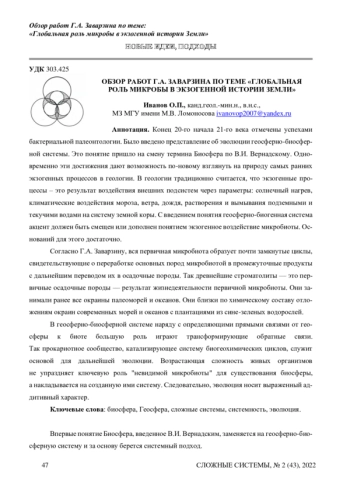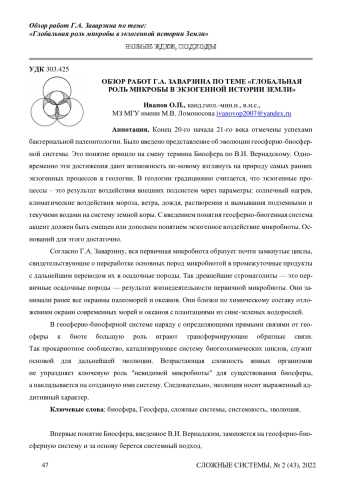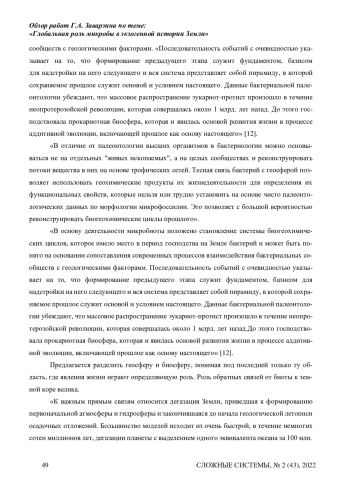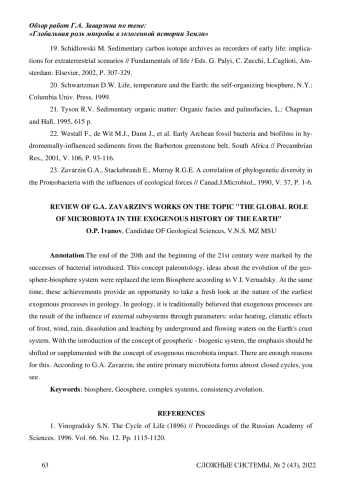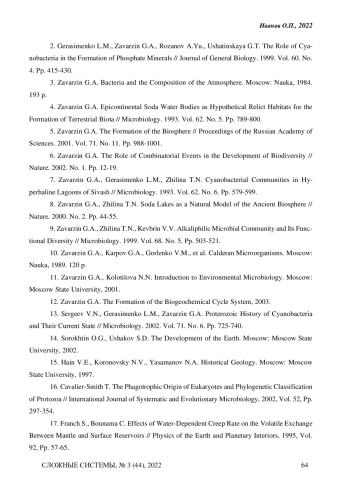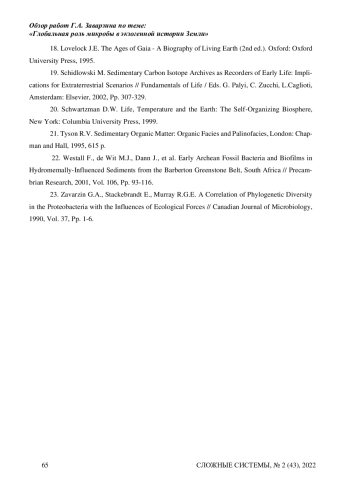Конец 20-го начала 21-го века отмечены успехами бактериальной палеонтологии. Было введено представление об эволюции геосферно-биосферной системы. Это понятие пришло на смену термина Биосфера по В. И. Вернадскому. Одновременно эти достижения дают возможность по-новому взглянуть на природу самых ранних экзогенных процессов в геологии. В геологии традиционно считается, что экзогенные процессы - это результат воздействия внешних подсистем через параметры: солнечный нагрев, климатические воздействия мороза, ветра, дождя, растворения и вымывания подземными и текучими водами на систему земной коры. С введением понятия геосферно-биогенная система акцент должен быть смещен или дополнен понятием экзогенное воздействие микробиоты. Оснований для этого достаточно. Согласно Г. А. Заварзину, вся первичная микробиота образует почти замкнутые циклы, свидетельствующие о переработке основных пород микробиотой в промежуточные продукты с дальнейшим переводом их в осадочные породы. Так древнейшие строматолиты - это первичные осадочные породы - результат жизнедеятельности первичной микробиоты. Они занимали ранее все окраины палеоморей и океанов. Они близки по химическому составу отложениям окраин современных морей и океанов с плантациями из сине-зеленых водорослей. В геосферно-биосферной системе наряду с определяющими прямыми связями от геосферы к биоте большую роль играют трансформирующие обратные связи. Так прокариотное сообщество, катализирующее систему биогеохимических циклов, служит основой для дальнейшей эволюции. Возрастающая сложность живых организмов не упраздняет ключевую роль “невидимой микробиоты” для существования биосферы, а накладывается на созданную ими систему. Следовательно, эволюция носит выраженный аддитивный характер.
The end of the 20th and the beginning of the 21st century are marked by the successes of bacterial paleontology. The concept of the evolution of the geosphere-biosphere system was introduced. This concept replaced the term Biosphere according to V. I. Vernadsky. At the same time, these achievements provide an opportunity to take a fresh look at the nature of the earliest exogenous processes in geology. In geology, it is traditionally believed that exogenous processes are the result of the influence of external subsystems through parameters: solar heating, climatic effects of frost, wind, rain, dissolution and leaching by groundwater and flowing waters on the Earth’s crust system. With the introduction of the concept of geospheric-biogenic system, the emphasis should be shifted or supplemented with the concept of exogenous microbiota impact. There are enough reasons for this. According to G. A. Zavarzin, the entire primary microbiota forms almost closed cycles, indicating the processing of basic rocks by the microbiota into intermediate products with their further transfer to sedimentary rocks. Thus, the oldest stromatolites are primary sedimentary rocks - the result of the vital activity of the primary microbiota. They previously occupied all the outskirts of the paleomores and oceans. They are similar in chemical composition to the sediments of the margins of modern seas and oceans with plantations of blue-green algae. In the geosphere-biosphere system, along with the defining direct links from the geosphere to biota, transformative feedbacks play an important role. Thus, the prokaryotic community, which catalyzes the system of biogeochemical cycles, serves as the basis for further evolution. The increasing complexity of living organisms does not eliminate the key role of the “invisible microbiota” for the existence of the biosphere, but is superimposed on the system they have created. Consequently, evolution has a pronounced additive character.
Предпросмотр статьи
Идентификаторы и классификаторы
- SCI
- Системология
- eLIBRARY ID
- 82963162
